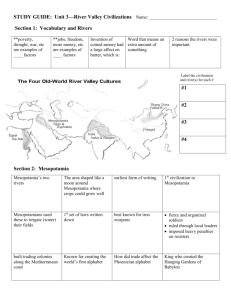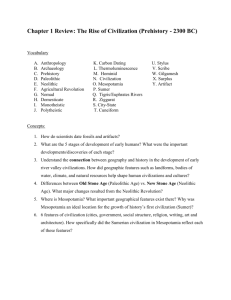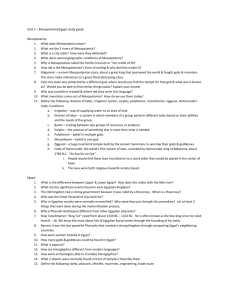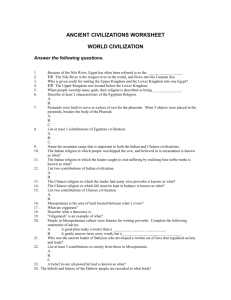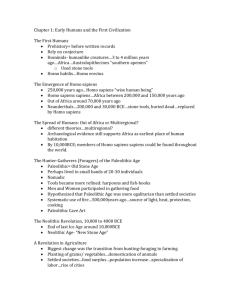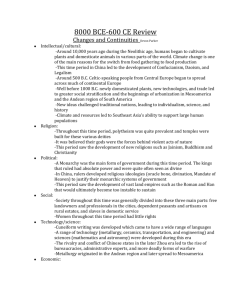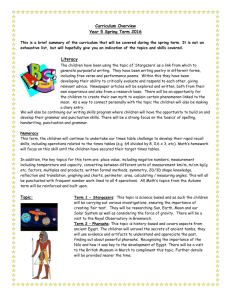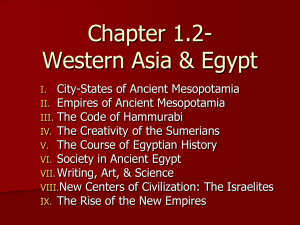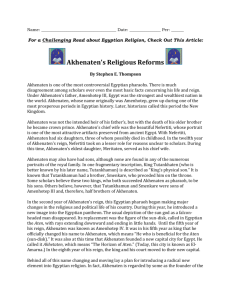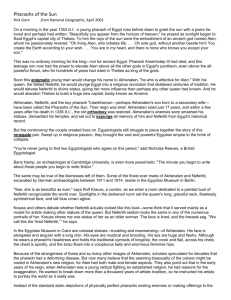Chapter 1 Outline and Summary Ancient Civilizations
advertisement
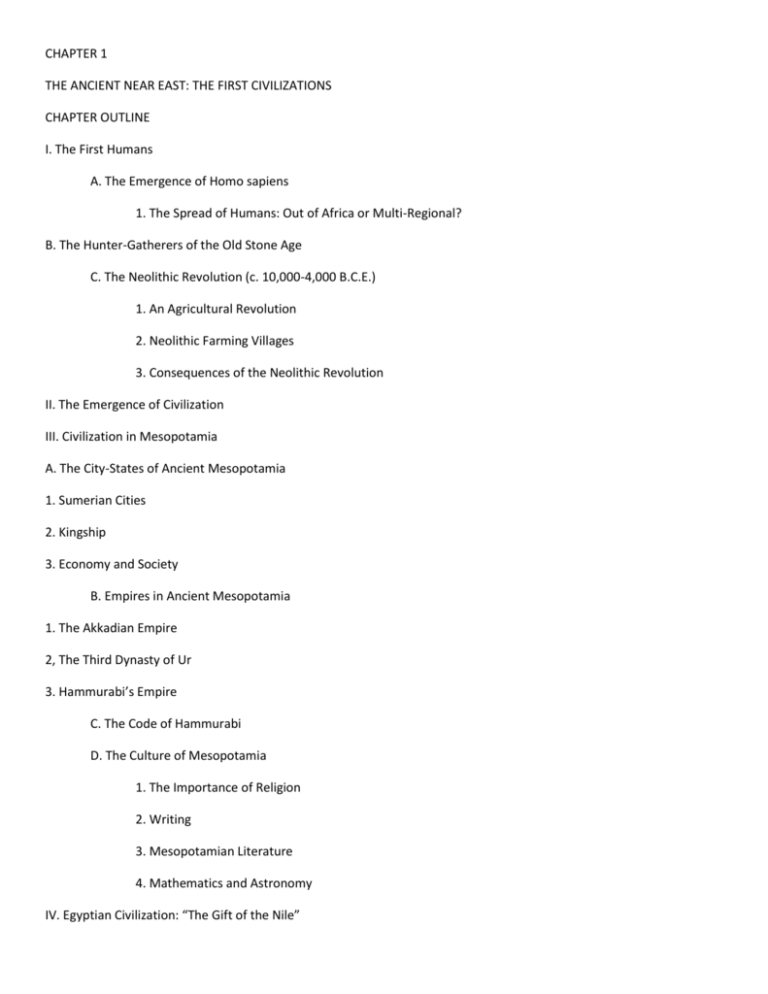
CHAPTER 1 THE ANCIENT NEAR EAST: THE FIRST CIVILIZATIONS CHAPTER OUTLINE I. The First Humans A. The Emergence of Homo sapiens 1. The Spread of Humans: Out of Africa or Multi-Regional? B. The Hunter-Gatherers of the Old Stone Age C. The Neolithic Revolution (c. 10,000-4,000 B.C.E.) 1. An Agricultural Revolution 2. Neolithic Farming Villages 3. Consequences of the Neolithic Revolution II. The Emergence of Civilization III. Civilization in Mesopotamia A. The City-States of Ancient Mesopotamia 1. Sumerian Cities 2. Kingship 3. Economy and Society B. Empires in Ancient Mesopotamia 1. The Akkadian Empire 2, The Third Dynasty of Ur 3. Hammurabi’s Empire C. The Code of Hammurabi D. The Culture of Mesopotamia 1. The Importance of Religion 2. Writing 3. Mesopotamian Literature 4. Mathematics and Astronomy IV. Egyptian Civilization: “The Gift of the Nile” A. The Impact of Geography B. The Old and Middle Kingdoms 1. The Old Kingdom 2. The Middle Kingdom C. Society and Economy in Ancient Egypt D. The Culture of Egypt 1. Spiritual Life in Egyptian Society 2. The Pyramids 3. Art and Writing E. Disorder and a New Order: The New Kingdom 1. The Egyptian Empire 2. Akhenaten and Religious Change 3. The End of Empire F. Daily Life in Ancient Egypt V. On the Fringes of Civilization A. The Impact of the Indo-Europeans 1. The Hittite Empire VI. Conclusion CHAPTER SUMMARY Africa was humanity’s cradle, and humankind’s beginnings were approximately three to four million years ago, according to the available archeological evidence. Through the many millennia early humans (hominids) began using stones, discovered fire, and in small bands they gathered wild plants and hunted wild animals. Modern humans, known as Homo sapiens sapiens, appeared first in Africa no later than 150,000 years ago, and eventually spread throughout the world by the end of the Paleolithic era, or the Old Stone Age. A significant change in living patterns occurred beginning c. 10,000 B.C.E. Known as the Neolithic (New Stone Age) Revolution, its significance was in producing food through the domestication of plants and animals, an event that first occurred in the upland regions of the Middle East’s Fertile Crescent. Permanent villages of up to a few thousand people replaced nomadic bands, pottery was made from clay, and goods were accumulated and traded. A division of labor appeared, and eventually men became the dominant gender because of their labor in food production. Increasing complexity led to the further development of what is called civilization, which is characterized by its urban focus, with more formal political and military institutions and religious and social structures, the use of writing, monumental architecture, and the production of metal, bronze being the earliest. Civilizations developed elsewhere in the world, but in the West it was in the river valleys of Mesopotamia and Egypt where civilization first appeared. By 3000 B.C.E., ancient Mesopotamia–the land between the Tigris and Euphrates Rivers–was a city-state civilization in Southwest Asia, created by a people known as the Sumerians. The rivers were tamed, but remained unpredictable, affecting both religion and the arts (notably in the Epic of Gilgamesh), priests and kings held a monopoly of power, temples (ziggurats) were constructed of brick, trade and commerce expanded, although most of the inhabitants were farmers. Writing on clay, known as cuneiform (wedge-shaped), began. Located on flat plains, the citystates were vulnerable to invasion. The result was the creation of a series of empires, beginning with the Akkadians c. 2340 B.C.E., later followed by the Babylonians, famous for Hammurabi’s law code (c.1750 B.C.E.). The centrality of religion was exemplified in the epics of Enuma elish and Gilgamesh. Civilization also developed along Egypt’s Nile River, a more predictable river than those in Mesopotamia, and Egyptian religion reflected its more benign nature. The Nile also served as a unifier of ancient Egypt, and surrounded by deserts, Egypt was less subject to invasion. Egyptian pharaohs were perceived as gods, unlike the rulers in Mesopotamia, and their tombs were the pyramids that were constructed during the Old Kingdom, c. 2575-2125 B.C.E. Religion was at the core, not least in the various divine manifestations of the ever-present sun. A quest for immortality developed, particularly around the cult of Osiris, and mummification became widespread during the Middle Kingdom (c. 2125-2010 B.C.E.), whose end coincided with an invasion of the Hyksos peoples. Native rule resumed during the New Kingdom (c. 1539-1069 B.C.E.), an era of Egyptian imperialistic expansion throughout much of the Middle East. During the 1330s B.C.E., a potentially radical religious revolution began with the pharaoh Amenhotep IV, who assumed the name Akhenaten, in honor of his god, Aten, god of the sun disk. His actions in closing the temples devoted to the other gods alienated the priesthood, particularly the priests of the powerful god, Amon-Re. After his death, the old gods were restored, but in his religious pursuits, Akhenaten had neglected foreign policy, and Palestine and Syria were lost from Egyptian rule. In the 1200s B.C.E., the so-called “Sea Peoples” invaded Egypt, and during the next millennium Egypt was often dominated by foreign empires, such as the Assyrian, Persian, and Macedonian. In the late first century B.C.E., Egypt became a Roman province. Farming appeared in Europe’s Balkans by 6500 B.C.E. and in central Europe by 4000 B.C.E. A characteristic of European societies during these millennia was the construction of large stone structures, or megaliths, the most famous being England’s Stonehenge. Indo-European speakers migrated into Europe and the Middle East around 2000 B.C.E. One Indo-European group, the Hittites, established a kingdom in Asia Minor c. 1700 B.C.E., and during its heyday the Hittite empire was one of the most formidable powers in western Asia, assimilating other cultures into its own. They, like the Egyptians, were attacked by the Sea Peoples and by aggressive tribespeople known as the Gasga, and by 1190 B.C.E., Hittite power had ended.
